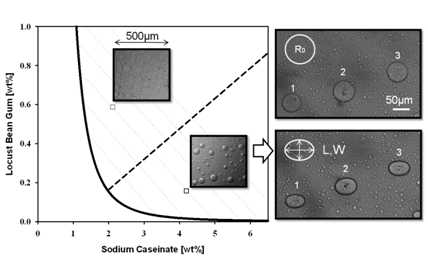Effects of sugar on mixed biopolymer systems
Asja Portsch, Fotios Spyropoulos & Ian Norton, University of Birmingham
The aim of this work is to better understand the structuring processes in low fat dairy emulsions. Model sodium caseinate-galactomannan aqueous two-phase systems (NaCAS-GM ATPS) differing in GM-type (locust bean gum (LBG), tara gum (TG), guar gum (GG), fenugreek gum (FG)) and added sugar (trehalose, sucrose, glucose and fructose) were studied by the phase-volume ratio method, rheooptics, and droplet retraction method on phase equilibria, flow behaviour and interfacial properties, respectively, at pH 5.8 and 20 °C.
The results revealed that the presence of sugar in concentrations 5-40 wt% resulted in an increase in cosolubility of the phases and a decrease in interfacial tension ( ). Sugar concentrations > 40 wt% decreased cosolubility. Based on the mannose:galactose ratio of GM and type of sugar (added in concentration 15 wt%) the best cosolubility and corresponding smallest was attributed to FG and trehalose, respectively. The flow of ATPS depended on quiescent microstructure, the shear and physical properties of the phases. In polysaccharide-continuous ATPS, the occurrence of a shear-induced phase inversion event was observed for 0-20 wt% sugar. A further increase in sugar concentration >20 wt% was found to suppress this phenomenon due decreased viscosity ratio and formation of thread like structures in flow.
Keywords: phase behaviour; microstructure, viscometry; phase inversion, interfacial tension, galactomannans; sodium-caseinate; sugars.
Graphic abstract:

The above figure shows a phase diagram of a sodium caseinate-locust bean gum system on which light micrographs of the protein-continuous and polysaccharide continuous systems are shown. The protein-continuous systems are shown in quiescent conditions and under shear.
Email

